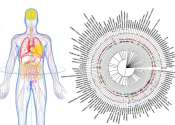In classical genetics, the genome of a diploid organism including eukarya refers to a full set of chromosomes or genes in a gamete; thereby, a regular somatic cell contains two full sets of genomes. In haploid organisms, including bacteria, archaea, viruses, and mitochondria, a cell contains only a single set of the genome, usually in a single circular or contiguous linear DNA (or RNA for retroviruses). In modern molecular biology the genome of an organism is its hereditary information encoded in DNA (or, for retroviruses, RNA).
The genome includes both the genes and the non-coding sequences of the DNA. The term was adapted in 1920 by Hans Winkler, Professor of Botany at the University of Hamburg, Germany. The Oxford English Dictionary suggests the name to be a portmanteau of the words gene and chromosome; however, many related -ome words already existed, such as biome and rhizome, forming a vocabulary into which genome fits systematically.
More precisely, the genome of an organism is a complete genetic sequence on one set of chromosomes; for example, one of the two sets that a diploid individual carries in every somatic cell. The term genome can be applied specifically to mean that stored on a complete set of nuclear DNA (i.e., the "nuclear genome") but can also be applied to that stored within organelles that contain their own DNA, as with the mitochondrial genome or the chloroplast genome. Additionally, the genome can comprise nonchromosomal genetic elements such as viruses, plasmids, and transposable elements. When people say that the genome of a sexually reproducing species has been "sequenced", typically they are referring to a determination of the sequences of one set of autosomes and one of each type of sex chromosome, which together represent both of the possible sexes. Even in species that exist in only one sex, what is described as "a genome sequence" may be a composite read from the chromosomes of various individuals. In general use, the phrase "genetic makeup" is sometimes used conversationally to mean the genome of a particular individual or organism. The study of the global properties of genomes of related organisms is usually referred to as genomics, which distinguishes it from genetics which generally studies the properties of single genes or groups of genes.
Both the number of base pairs and the number of genes vary widely from one species to another, and there is little connection between the two (an observation known as the C-value paradox). At present, the highest known number of genes is around 60,000, for the protozoan causing trichomoniasis (see List of sequenced eukaryotic genomes), almost three times as many as in the human genome.
An analogy to the human genome stored on DNA is that of instructions stored in a book:









